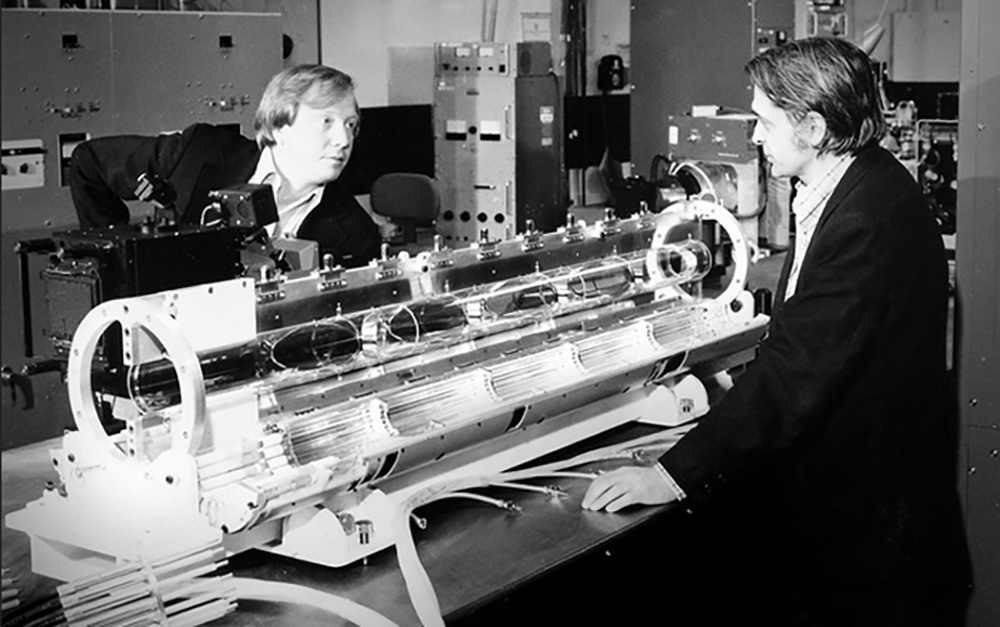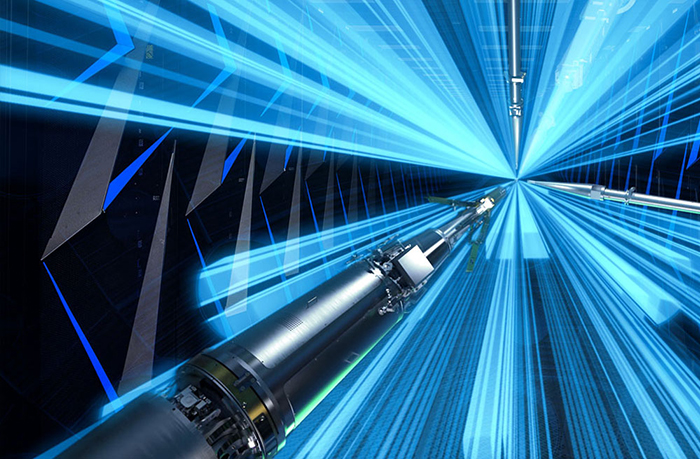Beaming with Excellence
August 11, 2022
The following is an excerpt from the cover story by Caryn Meissner in the April/May 2022 issue of Science & Technology Review:
Humankind’s history is a tapestry of invention and application, both scientific and technical. From learning to make tools and control fire, to understanding complex astrophysical phenomena and developing ever-more advanced machines, people are continually striving to investigate, innovate, and discover in the pursuit of knowledge.
In 2021, Lawrence Livermore researchers and colleagues from collaborating institutions working at the National Ignition Facility (NIF) added another stitch to this tapestry. After millennia of looking up at the stars, humankind now stands at the threshold of replicating one.
Recreating fusion, the process that powers the Sun, within a laboratory has long been a grand challenge of scientific research. On August 8, 2021, the research team conducted a shot that produced a record-breaking 1.35 megajoules (MJ) of fusion energy by imploding a deuterium-tritium (DT) fuel capsule with 1.9 MJ of laser energy.
The capsule, located within a hohlraum that converted the laser light into x rays, produced about six times as much fusion energy as the x-ray energy it absorbed. The shot marks the first time in a laboratory that scientists have observed signs of a self-sustaining wave of nuclear reactions—thermonuclear burn—in the DT fuel, opening a fundamentally new regime to explore and advance the Laboratory’s critical national security mission and future fusion energy applications
This monumental achievement was the culmination of painstaking efforts undertaken by a team of multidisciplinary experts over multiple decades. Since the inception of Lawrence Livermore’s Laser Program 50 years ago, scientists and engineers from across the Laboratory have been at the forefront of scientific and technological innovations that have paved the way to the August 2021 milestone.
These advancements were a concerted effort of Livermore and collaborators including industrial and academic partners, Los Alamos and Sandia national laboratories, the University of Rochester’s Laboratory for Laser Energetics (LLE), General Atomics, and the Massachusetts Institute of Technology (MIT). Being at the threshold of ignition as defined by the National Academy of Sciences (NAS)—where more energy is produced by the fusion reactions inside the fuel capsule than the amount of laser energy delivered to the target—builds on the work of the entire team, including the people who pioneered inertial confinement fusion (ICF) research since the Laboratory’s earliest days.
Driven by Purpose…and Lasers
In the 1950s, Laboratory physicist John Nuckolls and colleagues were investigating whether it was possible to ignite a fusion explosion without a fission bomb as a means of generating power for commercial applications. They ran the latest, state-of-the-art computer codes and found that radiation at temperatures of a few hundred electronvolts (eV) could implode a capsule of DT fuel and initiate a very small-scale fusion explosion. However, the process needed a driver. When physicist and engineer Theodore Maiman demonstrated the first laser in 1960, its implications for other fields of research began to take shape. Nuckolls, who later became Laboratory director, saw the laser as the tool for achieving fusion ignition through ICF, wherein the small mass of DT could be compressed and heated through the laser-driven implosion of the fuel capsule.
 Physicists John Emmett (left) and John Nuckolls were two of the most influential pioneers of the Laboratory’s Laser Program and inertial confinement fusion (ICF) science and technology.
Physicists John Emmett (left) and John Nuckolls were two of the most influential pioneers of the Laboratory’s Laser Program and inertial confinement fusion (ICF) science and technology. Throughout the 1960s, nascent experimental laser research at the Laboratory was disjunct, and progress was slow to develop a high enough power laser for fusion applications. In 1971, Laboratory Director Michael May and Associate Director for Plans Carl Haussmann took steps to consolidate the distributed expertise in ICF code development, specifically LASNEX; laser–plasma interactions (LPIs); and high-power, short-pulse lasers into a single program.
Haussmann, the program’s first leader, built a crackerjack team with the help of John Emmett, who was head of solid-state laser research at the Naval Research Laboratory and became the Laboratory’s Y-Division leader in 1972; and physicist William Krupke from Hughes Aircraft Company.
Under their collective leadership, the scope of the Laser Program expanded, the workforce grew, and plans were initiated to construct a series of bigger, more complex, higher energy lasers for achieving ICF.
Altogether, six large fusion laser systems were engineered and built in 10 years after the Laser Program’s inception, and the pace of laser construction matched the growth of diagnostics and target fabrication capabilities, computer simulation tools, and theoretical understanding to continually improve laser capabilities and experimental results.
Emmett attributes this success to the people. “We had several hundred people working together in amazing harmony to accomplish something that we all thought was terrifically exciting,” he says. “I’d never seen a team work together the way we did.”
To read the full story, go to Science & Technology Review.
More Information:
“NIF Celebrates 50 Years of Laser Innovation,” NIF & Photon Science News, August 16, 2022
Video: “50 Years of LLNL Lasers,” NIF & Photon Science News, July 21, 2022
“Threshold of Ignition,” NIF & Photon Science News Special Report
“A Legacy of Lasers and Laser Fusion Pioneers”
—Caryn Meissner
(Additional resources provided by John Lindl and Paul Chrzanowski)
Follow us on Twitter: @lasers_llnl




